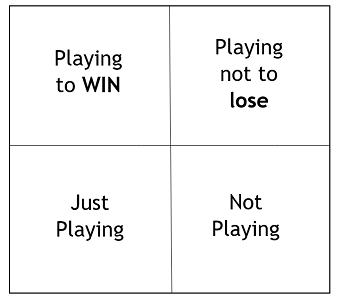#3 Playing Not to Lose
I have a diagram I’ve used in teaching leadership for 30 years, it looks like this:

It’s useful in many ways. In business, you can assess your team based on how they are playing and offer feedback accordingly. This model provides a framework for improvement if a person isn’t showing up as powerfully as they either believe they are or would intend to be.
The dialog can evolve from how the person is currently “playing” to how they intend to be playing by the time of their next review and what actions they need to take to move forward most effectively.
What’s most impactful about this model for me, is that very few people ever play to “WIN.” The vast majority of us “play not to lose.” It’s safer there. And really, there’s only one distinction between “playing not to lose” and “playing to WIN.” It’s a big distinction however, that’s why so few people attempt it. And it’s a game changer when it happens, regardless of the outcome.
Do you know what the distinction is? Please leave your answer in the comments below, so we can all learn together. I’ll give the answer and explanation in Blog #7.
